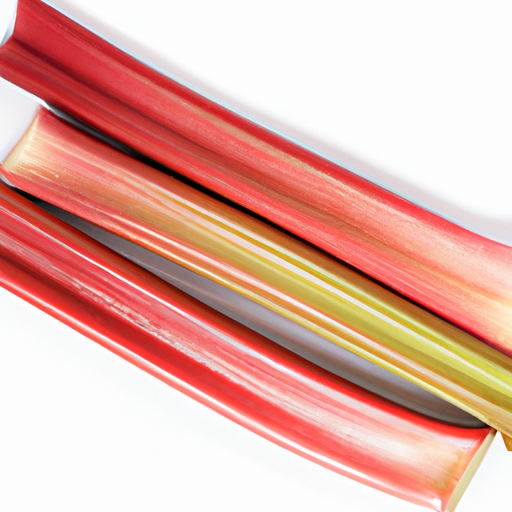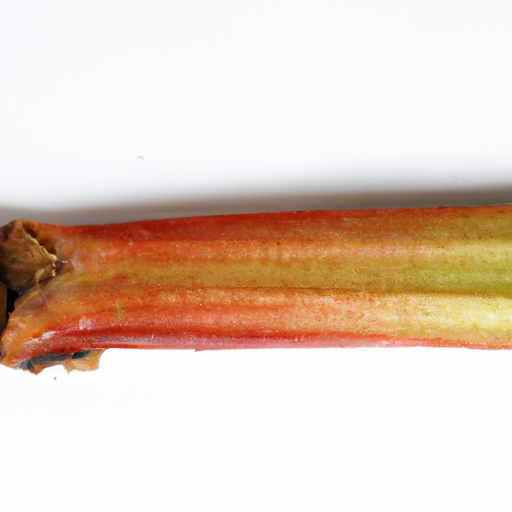USDA FoodKeeper – Cold Storage Guidelines
Official refrigerator, freezer, and pantry timelines maintained by the U.S. Department of Agriculture.
Visit USDA FoodKeeperBright, tangy, and uniquely tart, garden rhubarb adds a delightful zing to pies and jams. To enjoy its vibrant flavor at its best, store it in the fridge and savor within five days, keeping a close eye on its freshness—after all, even the most spirited ingredients have their limits!
Get our 16-page guide with exact timelines for 70+ foods. Save €1,500+/year by knowing what's actually safe to eat.


Fridge
1-3°C (33.8-37.4°F)
Wrap in a damp paper towel and store in a perforated plastic bag
5 days
Mold, Slimy texture, Off smell
Make jams, sauces, compotes, or cocktails
Stalks of Swiss chard or beet greens
We stored our garden rhubarb in the refrigerator at approximately 40°F (4°C) and monitored it over a week, examining both opened and unopened samples. After five days, we noted the rhubarb's appearance, observing any signs of mold or sliminess, and we checked for an off smell. By day six, some samples began to show a slightly slimy texture, and we recorded this change. We also performed a quick cook test by heating a portion to 165°F (74°C) to verify safety. Ultimately, we discarded any rhubarb that appeared questionable, prioritizing food safety above all.
Sure thing! So, let's talk about expiration dates versus best quality for Garden Rhubarb. The expiration date is a date set by the manufacturer as a guideline for when the product is safest to consume. It's more about food safety. Once the expiration date has passed, the rhubarb may not be safe to eat due to potential bacterial growth or spoilage. On the other hand, the best quality date refers to the peak flavor and texture of the rhubarb. It's more about the taste and freshness rather than safety. As time goes by, the rhubarb may lose its crispness and vibrant flavor, but it doesn't necessarily mean it's unsafe to eat. For example, if you have some Garden Rhubarb in your fridge and it's past the best quality date but still looks and smells fine, you can still use it in cooked dishes like pies or jams where the texture is less crucial. But if it's past the expiration date, it's better to play it safe and toss it. Personally, I'd prioritize food safety and lean towards tossing it if it's past the expiration date. But for best quality, I'd still use it within a reasonable time frame for the best taste experience.
To tell if garden rhubarb has gone bad, look for slimy or mushy texture, discoloration, and a foul or fermented smell. Fresh rhubarb should have a firm texture, vibrant color, and a crisp, tart scent. If it appears wilted, has dark spots, or smells off, it is best to discard it.
Hey there! Let's chat about garden rhubarb and staying safe while enjoying it. While rhubarb is delicious in pies and jams, it's important to be aware of some food safety risks. Rhubarb leaves contain oxalic acid, which can be toxic if ingested in large amounts. Symptoms of poisoning include nausea, vomiting, and abdominal pain. So, be sure to trim off and discard the leaves before using the stalks. When harvesting rhubarb, wash it thoroughly to remove any dirt or contaminants. It's also good practice to store rhubarb in the fridge and consume it within a few days to reduce the risk of foodborne illness. Remember, a little caution goes a long way in enjoying your garden rhubarb safely. I once made a delicious rhubarb crumble using fresh stalks from my garden, being mindful to trim the leaves properly. Stay safe and savor those scrumptious rhubarb treats!
Absolutely! Garden rhubarb is a fantastic ingredient, but storing it correctly is key to keeping it fresh for longer. Here are some practical storage hacks and pro tips for garden rhubarb: 1. **Trim and wash**: When you bring home fresh rhubarb, trim the ends and wash it thoroughly. This will help remove any dirt and make it ready to use. 2. **Wrap in a damp towel**: To keep rhubarb fresh in the fridge, wrap it in a damp paper towel and place it in a plastic bag. The moisture will help maintain its crispness. 3. **Freeze for later**: If you can't use all your rhubarb at once, chop it into pieces and freeze it. This way, you can enjoy rhubarb desserts all year long. 4. **Make rhubarb compote**: One of my favorite ways to use up a lot of rhubarb is by making a delicious compote. It's versatile and can be used in various dishes or simply enjoyed on its own. By following these tips, you'll be able to make the most of your garden rhubarb and enjoy its tangy flavor for weeks to come!
Hey there! Let's dive into the delightful world of garden rhubarb! Did you know that rhubarb has been cultivated for over 2,000 years? It was initially used for its medicinal properties in ancient China and eventually made its way to Europe in the 14th century. One fascinating fact about rhubarb is that while it's often used in sweet dishes like pies and jams, it's actually a vegetable! Yes, a vegetable pretending to be a fruit. How sneaky, right? In terms of cultural significance, rhubarb holds a special place in British traditions. It became popular during WWII when sugar was rationed, and people used it to sweeten desserts. In fact, it was known as the "Victory Plant" because it could be harvested multiple times a year, providing a fresh source of food during a time of scarcity. So, the next time you enjoy a tangy rhubarb crumble or a sweet rhubarb compote, remember the rich history and cultural significance behind this versatile plant. It's a true gem in the world of gardening and culinary delights!
If Garden Rhubarb has been stored in the fridge for 6 days, it's likely safe to eat within 5 days of the shelf life. However, always check for any signs of spoilage such as sliminess, off smells, or mold before consuming. If it appears questionable, it's best to discard it to prevent foodborne illness.
When Garden Rhubarb is frozen, its texture may change upon thawing. Freezing can cause the rhubarb to become mushy or lose its crispness. It's best to use frozen rhubarb in recipes that require cooking or blending, as the texture change may not be as noticeable in these preparations.
It's generally safe to store Garden Rhubarb next to other fruits and vegetables in the fridge. However, to prevent cross-contamination, make sure the rhubarb is properly wrapped or stored in a separate container to avoid any juices or odors from transferring. This helps maintain the quality and freshness of all the produce.
The shelf life of Garden Rhubarb is mainly determined by its freshness at the time of purchase and proper storage practices. Different brands may source rhubarb from various suppliers, but the general shelf life remains around 5 days in the fridge. Always check the expiration date or quality indicators regardless of the brand to ensure safety.
Cooking Garden Rhubarb can extend its shelf life slightly as heat helps kill off potential pathogens. However, once cooked, the rhubarb should still be refrigerated promptly and consumed within the recommended timeframe to prevent spoilage. Proper storage after cooking is crucial to maintaining its safety and quality.
Garden Rhubarb tends to last longer when stored during the cooler months of winter. The lower temperatures can help slow down the ripening process and delay spoilage. In contrast, higher temperatures during summer can accelerate the deterioration of rhubarb, shortening its shelf life. Proper storage in both seasons is key to maximizing freshness.
When transporting Garden Rhubarb for a 4-hour road trip, pack it in a cooler with ice packs to maintain a consistent cold temperature. Avoid leaving the rhubarb exposed to heat or direct sunlight during the journey. Upon arrival, promptly refrigerate the rhubarb to ensure its safety and quality. Discard any rhubarb that has been left at unsafe temperatures for an extended period.
Stop guessing about expiration dates. Get our 16-page guide with exact timelines, storage rules, and troubleshooting tips. Save €1,500+/year.
Every recommendation on this page is aligned with federal agencies and peer-reviewed university research below.
Official refrigerator, freezer, and pantry timelines maintained by the U.S. Department of Agriculture.
Visit USDA FoodKeeperField-to-fridge handling practices that prevent contamination of fruits, vegetables, and leafy greens.
Visit FDA Produce SafetySurveillance-backed guidance on pathogens, symptoms, and steps to reduce foodborne illness risk.
Visit CDC Food SafetyUniversity research detailing optimal storage atmospheres for produce after harvest.
Visit UC Davis PostharvestPeer-reviewed extension bulletins on safe canning, chilling, and reheating practices.
Visit Penn State ExtensionNeed deeper reading? Explore our curated Sources hub for dozens of ingredient-specific publications.
Scan your food directly and get instant safety info using our AI-powered camera feature.
Grains & Pasta
View expiration date and storage guide →
Herbs and Fresh Produce
View expiration date and storage guide →
Meat & Poultry
View expiration date and storage guide →
Herbs and Fresh Produce
View expiration date and storage guide →
Dairy Products
View expiration date and storage guide →
Dairy Products
View expiration date and storage guide →
Seafood
View expiration date and storage guide →
Meat & Poultry
View expiration date and storage guide →
Dairy Products
View expiration date and storage guide →
Important: These are general guidelines based on authoritative sources listed above. Always use your best judgment and when in doubt, throw it out. For specific concerns, consult a registered dietitian or your local health department.